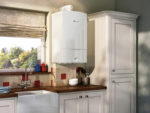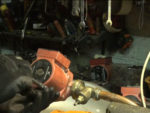This section covers all the essentials about a domestic central heating system. We cover the maintenance tasks you should do and when, we cover all the common problems that can occur with central heating and how you can fix them. There is comprehensive information on all aspects of central heating systems.
We do not cover Radiators and other heating elements or emitters as this is a large topic in its own right and is covered in a separate section.
Heating and Zoning Controls are also covered in a separate section, as is all the information that you might need about Hot Water Systems.
Types of Central Heating System
In this country we really only use one of three types of central heating system:
- Wet systems – these use a boiler or heat exchanger to heat water which is transferred to your home through radiators, heated rails or under floor heating
- Electric Heating – such as storage heater or electric radiators. This form of heating equates to less than half a percentage of homes in the UK (United Kingdom housing energy fact file: 2013)
- Warm Air Systems – These heat the air and blow it into your home. This is more common in North America or commercial buildings so rarely found here
Wet Central Heating Systems make up in excess of 95% of the domestic central heating, so we will focus on this type of central heating.
Different Types of Wet Central Heating Systems
All wet central heating systems have the same components; A boiler to heat the water and a device to transfer the heat to your room, usually a radiator or possibly underfloor heating.
Boilers can be powered by a number of fuels most typically gas – over 90% of homes use gas for heating. Oil is popular especially off the gas network, but other fuels can be used such as LPG or Solid Fuel.
Whatever the fuel that powers the central heating system or whichever solution is use to transfer the heat from the water to the room it does not affect the types of central heating system. There are 3 types of wet central heating system commonly used in this country:
- Combi Boiler Systems – This is short for a Combination Boiler as it heats both the water for your taps and it also heats the central heating system. These are the most popular systems used by around 70% of homes. They are ideal for smaller homes, with only one or two bathrooms where the demand for hot water isn’t too great. They are compact so save a lot of space as they don’t need a hot water tank. They provide instant hot water, heating the water on demand, but they cannot deal with a high demand and will result in a low flow rate when several (hot) taps are on at once
- Sealed Systems – This system heats water that is then stored in a hot water cylinder, generally found in an airing cupboard. It does not heat the water that comes out of the taps directly like a combi boiler, but this is heated in the cylinder. The water simply circulates in the system, heating up in the boiler and then transferring the heat to the rooms through radiators or to the hot water through the cylinder. This is a sealed loop, and if the pressure drops, because of small leaks, then you might need to add more water to top up the pressure for the system to work efficiently. A sealed system is ideal for a larger home that needs more heating and hot water than a combi boiler can provide. This means that several showers can be had at once, and there is no need for a tank in the loft. You are reliant of the tank of hot water, which once it is used up, so you will have to wait for the next tank to heat up before you can have hot water again. An airing cupboard or similar to put your cylinder is also required
- Open Vent Systems – These are more complex systems, where the boiler heats the water in a cylinder, and then heats the home through radiators or similar as with the sealed system. However as opposed to being sealed and the pressure topped up periodically as required, an open system automatically tops up from a tank in the loft, and excess pressure is vented back into the tank in the loft. These systems are idea for larger homes, like sealed systems, but where sufficient pressure cannot be achieved. Like a sealed system, they have the advantage of allowing a good flow of hot water even with several taps on, and they can be used when there is a lack of mains pressure. As will the tank in the loft, they also have a tank of hot water, which can run out and will take up space. As they are open, it is more likely that pollutants can enter the system meaning that more maintenance could be required



The different types of central heating system probably have a greater noticeable impact of the hot water in your home, but the central heating system and boiler is inextricably linked. It is important to understand which kind of system that you have before you start any type of fault finding or maintenance.
















